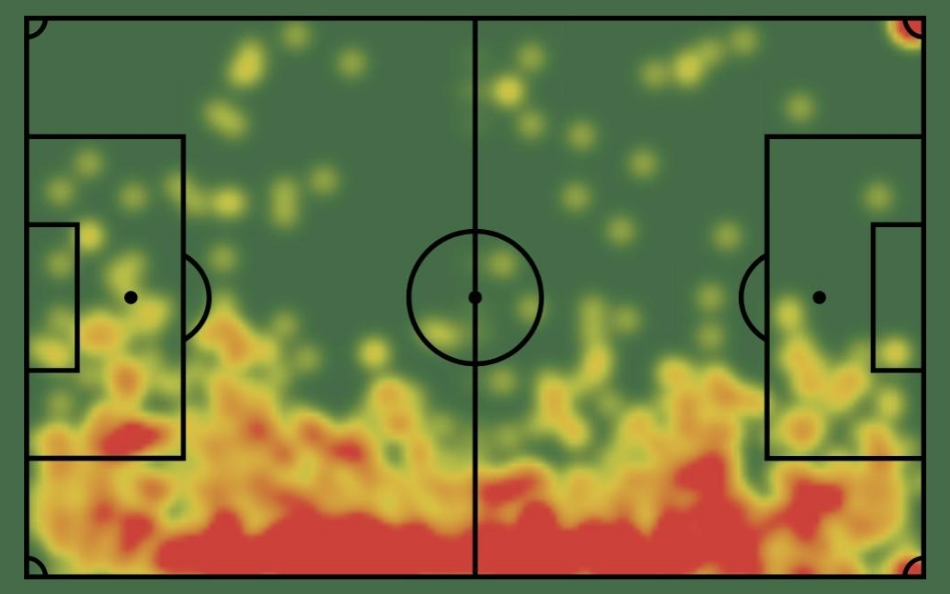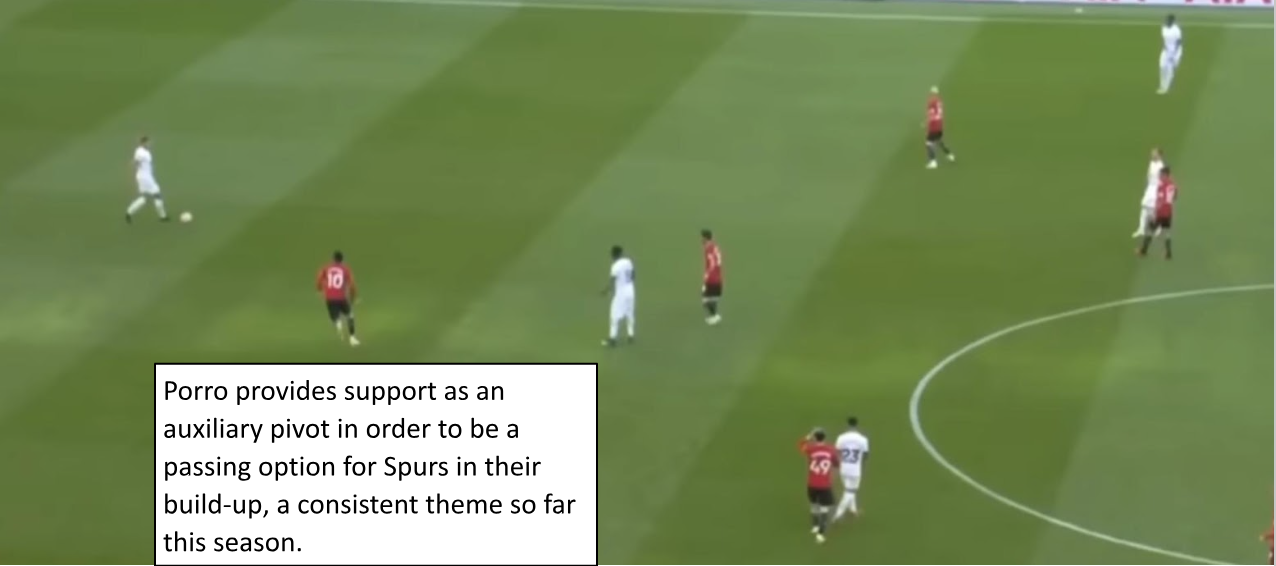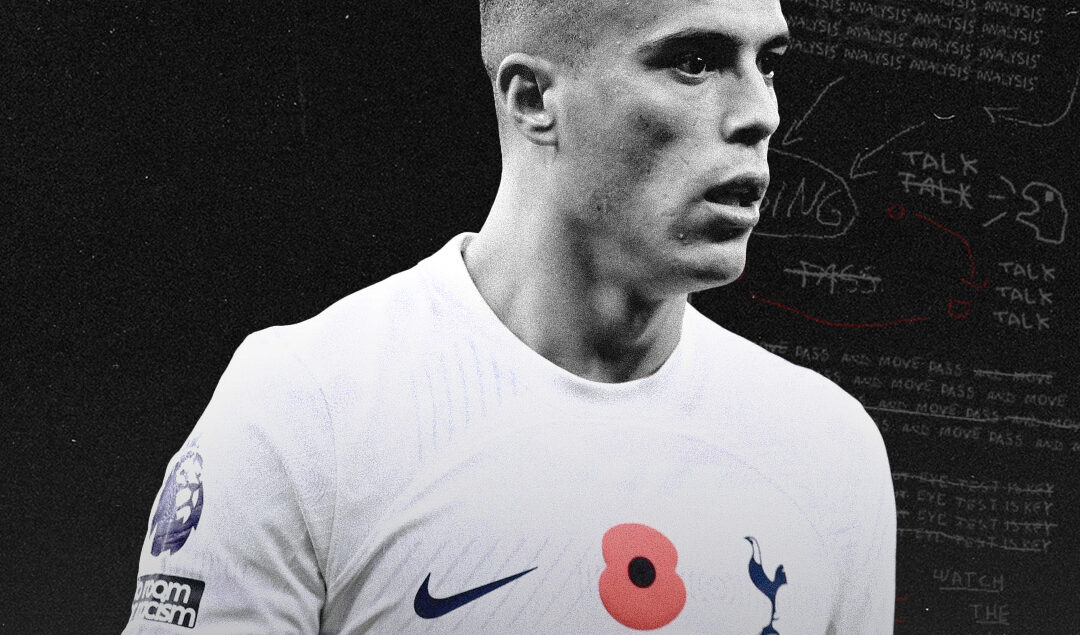Pedro Porro’s Revitalisation under Ange Postecoglou
Pedro Porro experienced a half-season of mixed fortunes after his transfer to Tottenham in January 2023. After securing a £40 million move to Spurs from Sporting CP, he arrived with a determination to prove himself in England following a three-year stint at Man City where he made zero appearances and instead was loaned out to Real Valladolid and Sporting.
Antonio Conte, in search of dynamic fullbacks for his system, found in Porro the ideal profile to enact his principles. However, just as Conte’s time at Spurs turned sour, so did his form. The Spaniard’s attacking prowess, once a standout feature, waned, and he began to look increasingly vulnerable 1v1. The promising start to Porro’s Tottenham journey gave way to inconsistencies, paralleling the challenges faced by the team under Conte’s tutelage.
When Ange Postecoglou, a manager internationally renowned for maximising player potential, took the reins at Spurs, Porro took no time in emerging as a crucial component to the club’s best-ever start to the season after ten matches. While both Ange and Conte prioritise fullbacks in their respective systems, the similarities virtually begin and end there.
Unlike Conte’s approach, where fullbacks contribute width to the attack from the outside, Ange positions his fullbacks invert and act as auxiliary midfielders. Under Ange’s guidance, fullbacks play a pivotal role in providing passing triangles, executing third-man runs, and facilitating central progression throughout all phases of play.
His Story So Far
The Spaniard broke through in La Liga with Girona, replacing fellow ex-Manchester City fullback Pablo Maffeo. He established himself as the starter under boss Eusebio Sacristan and made 32 league appearances at just 19 years old. During the 2018/19 season, Porro made 7.29 ball recoveries per 90 – which was the second highest among La Liga fullbacks that season.
By making such a strong impression at Girona – whom the City Football Group own 44.3% of – Porro was rewarded with a move to Pep Guardiola’s Manchester City. Despite three years of the champions’ books where Porro failed to make one appearance for the club, he looks back at the time with reverence, claiming that he accepts the situation he dealt with at City and that it was simply “part of football.”
In his first year at City, Porro embarked on a loan to Real Valladolid. But despite helping the club to a 13th-placed finish, Valladolid opted against exercising the option-to-buy clause in his contract. However, Porro’s fortunes took a positive turn during his loan spell at Sporting CP, where he secured three trophies and earned consecutive inclusions in the Primeira Liga Team of the Year. In 2022, Sporting CP decided to permanently acquire Porro for a modest £8 million.
The Midas Touch: Ange Postecoglou’s Impact at Tottenham Hotspur
What Has Changed for Porro?
The January 2023 window was an eagerly anticipated one for Antonio Conte and the Tottenham supporters, ultimately ending with the acquisition of one of Conte’s most heavily requested signings. Prior to joining Spurs, Porro established himself as one of the most in-form, modern, and attacking fullbacks in Europe.
Notably, his output in the Primeira Liga included 6 goals and 2 assists in just 12 starts. In the first half of his season, he served as a supplementary attacker for Ruben Amorim’s side, averaging 62 progressive carries in 14 games, which is effectively illustrated in his heat map.

Photo: Porro’s 2021/22 heat map for Sporting [Sofascore]
Following his move to Tottenham, Porro provided the same typical dynamism and attacking intent that proved successful during his time at Sporting. Evident of this, Porro provided more crosses into the penalty area per 90 (1.11) than any other fullback in the Premier League last season. Moreover, his 0.48 goal-creating actions per 90 surpassed all other fullbacks in the league as well.
He provided width and effectively supplemented the attack from the wide positions. However, as Spurs experienced a dip in form that ultimately led to Conte’s departure from the dugout, his defensive awareness faced continuous scrutiny, echoing the concerns Spurs fans had with Emerson Royal, another one of Conte’s fullback purchases. Ironically, this season under Ange, a manager who places high emphasis on attacking football, Porro has shown significant improvement in his defensive numbers.

Porro’s defensive improvement over the past year at Tottenham is reflected in his stats.
Another intriguing parallel between the Porro of this season and last season is how he is being used in possession. Postecoglou, unlike Conte, looks outside of his fullbacks when looking for width, preferring them to invert in-field all the way through the build-up phase.
Porro, as well as Destiny Udogie, has been integral to Spurs’ building out from the back, offering passing options as well as vertical progression through central channels. Porro is averaging 21 passes in his own half compared to 12.5 with Spurs last season. His underlaps have also been crucial to the attacking phase for Spurs this season, yet his impact from wider positions hasn’t reduced as a result. Evidence of his impact, Porro has taken more shots per 90 (1.77) than any other fullbacks in Europe’s top five leagues.

Porro’s dynamism has helped Spurs through all phases of play, highlighting his in-game reading of play in knowing which pockets to occupy and when. Stylistically and statistically, Porro stands out as one of Europe’s most elite fullbacks. His impressive tally of five assists and eight big chances created illustrate his exceptional creative abilities. But Porro doesn’t just provide an industrious and tactically intelligent profile to the fullback position; he also showcases proficiency in his defensive duties, culminating in what is now, an extremely well-rounded player.
Currently thriving in a positive environment, Porro’s impact is evident, and with just a year in English football at the age of 24, his bright start in a new league suggests that his best is undoubtedly yet to come for Spurs, and potentially his national team. He hasn’t played for Spain since March 28 in a 2-0 defeat to Scotland, but if he can keep improving at this rate, Luis de la Fuente may have no other choice but to give him a second chance as he looks for a long-term option at the right back position to replace the likes of Dani Carvajal (31), Jesus Navas (38) and Cesar Azpilicueta (34) in La Roja’s defense.
By: @free__flowing
Featured Image: @GabFoligno / Sebastian Frej / MB Media / Getty Images
